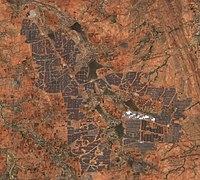
Photo from wikipedia
Wireless sensor networks (WSNs) are extensively used in various fields. However, limited battery power is one of the largest challenges to deploy WSNs application, thus reduce of node energy consumption… Click to show full abstract
Wireless sensor networks (WSNs) are extensively used in various fields. However, limited battery power is one of the largest challenges to deploy WSNs application, thus reduce of node energy consumption has become research focus. The common method to save energy is to use sleeping–awaking mechanism for node. Therefore, IST-REC (improved sleep time-based relieved energy consumption) based on optimized sleep time was proposed. IST-REC algorithm was used to improve energy efficiency of node through dynamic set of sleep time for node. IST-REC algorithm was used to firstly establish sensing model for an abnormal event so as to predict occurrence rate of the next abnormal event for establishing cost function according to residual energy factor of node and data risk factor. Conflict between network energy consumption and detection delay of abnormal events could be balanced through cost function. Eventually, cost function could be solved through bisection method so as to obtain the optimal sleep time. The experimental data indicates that proposed IST-REC algorithm can effectively reduce energy consumption and can prolong network lifetime at the time of not increasing detection delay for abnormal events.
Journal Title: Cluster Computing
Year Published: 2018
Link to full text (if available)
Share on Social Media: Sign Up to like & get
recommendations!